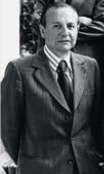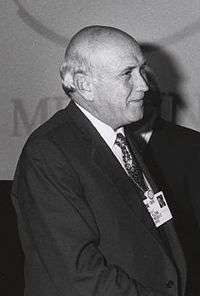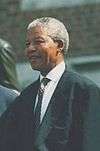Negotiations to end apartheid in South Africa
The apartheid system in South Africa was ended through a series of negotiations between 1990 and 1993 and through unilateral steps by the de Klerk government. These negotiations took place between the governing National Party, the African National Congress, and a wide variety of other political organisations. Negotiations took place against a backdrop of political violence in the country, including allegations of a state-sponsored third force destabilising the country. The negotiations resulted in South Africa's first non-racial election, which was won by the African National Congress.
Background
Apartheid was a system of racial discrimination and segregation in South African government. It was formalised in 1948, forming a framework for political and economic dominance by the white population and severely restricting the political rights of the black majority.
Between 1960 and 1990, the African National Congress and other mainly black opposition political organisations were banned. As the National Party cracked down on black opposition to apartheid, most leaders of ANC and other opposition organisations were either imprisoned or went into exile.
However, increasing local and international pressure on the government, as well as the realisation that apartheid could neither be maintained by force forever nor overthrown by the opposition without considerable suffering, eventually led both sides to the negotiating table.
Mahlabatini Declaration of Faith
On 4 January 1974, Harry Schwarz, leader of the liberal-reformist wing of the United Party, met with Gatsha (later Mangosuthu) Buthelezi, Chief Executive Councillor of the black homeland of KwaZulu, and signed a five-point plan for racial peace in South Africa, which came to be known as the Mahlabatini Declaration of Faith.

.jpg)
The declaration stated that "the situation of South Africa in the world scene as well as internal community relations requires, in our view, an acceptance of certain fundamental concepts for the economic, social and constitutional development of our country". The declaration's purpose was to provide a blueprint for government of South Africa for racial peace in South Africa. It called for negotiations involving all peoples, in order to draw up constitutional proposals stressing opportunity for all with a Bill of Rights to safeguard these rights. It suggested that the federal concept was the appropriate framework for such changes to take place. It also affirmed that political change must take place through non-violent means.[1]
The declaration was the first of such agreements by acknowledged black and white political leaders in South Africa that affirmed to these principles. The commitment to the peaceful pursuit of political change was declared at a time when neither the National Party nor the African National Congress were looking to peaceful solutions or dialogue. The declaration was heralded by the English speaking press as a breakthrough in race relations in South Africa. Shortly after it was issued, the declaration was endorsed by several chief ministers of the black homelands, including Cedric Phatudi (Lebowa), Lucas Mangope (Bophuthatswana) and Hudson Nisanwisi (Gazankulu).[2] Despite considerable support from black leaders, the English speaking press and liberal figures such as Alan Paton, the declaration saw staunch opposition from the National Party, the Afrikaans press and the conservative wing of Harry Schwarz's United Party.[3]
Early contact
The very first meetings between the South African Government and Nelson Mandela were driven by the National Intelligence Service (NIS) under the leadership of Niel Barnard and his Deputy Director General, Mike Louw. These meetings were secret in nature and were designed to develop an understanding about whether there were sufficient common grounds for future peace talks. As these meetings evolved, a level of trust developed between the key actors (Barnard, Louw, and Mandela).[4] To facilitate future talks while preserving secrecy needed to protect the process, Barnard arranged for Mandela to be moved off Robben Island to Pollsmoor Prison in 1982. This provided Mandela with more comfortable lodgings, but also gave easier access in a way that could not be compromised. Barnard therefore brokered an initial agreement in principle about what became known as "talks about talks". It was at this stage that the process was elevated from a secret engagement to a more public engagement.
The first less-tentative meeting between Mandela and the National Party government came while P. W. Botha was State President. In November 1985, Minister Kobie Coetsee met Mandela in the hospital while Mandela was being treated for prostate surgery. Over the next four years, a series of tentative meetings took place, laying the groundwork for further contact and future negotiations, but little real progress was made, and the meetings remained secret until several years later.[5]
As the secret talks bore fruit and the political engagement started to take place, the National Intelligence Service withdrew from centre stage in the process, and moved to a new phase of operational support work. This new phase was designed to test public opinion about a negotiated solution. Central to this planning was an initiative that became known in Security Force circles as the Dakar Safari, which saw a number of prominent Afrikaner opinion-makers engage with the African National Congress in Dakar, Senegal and Leverkusen, Germany at events organized by the Institute for a Democratic Alternative for South Africa.[6] The operational objective of this meeting was not to understand the opinions of the actors themselves—that was very well known at this stage within strategic management circles—but rather to gauge public opinion about a movement away from the previous security posture of confrontation and repression to a new posture based on engagement and accommodation.[4]
Unbanning of opposition organisations and the release of Mandela
When F.W. de Klerk became President in 1989, he was able to build on the previous secret negotiations with the imprisoned Mandela. The first significant steps towards formal negotiations took place in February 1990 when, in his speech at the opening of Parliament, de Klerk announced the unbanning of the African National Congress (ANC) and other banned organisations, and the release of ANC leader Nelson Mandela after 27 years in prison.
Initial negotiations
Groote Schuur Minute
The negotiations began with a meeting between the African National Congress and the South African government on 4 May 1990 at the presidential residence, Groote Schuur.


This resulted in the Groote Schuur Minute, a commitment between the two parties towards the resolution of the existing climate of violence and intimidation as well as the removal of practical obstacles to negotiation including immunity from prosecution for returning exiles and the release of political prisoners.[7]
Pretoria Minute
On 6 August 1990 the South African government and the African National Congress extended the consensus to include several new points. This Pretoria Minute included the suspension of the armed struggle by the ANC and its military wing Umkhonto we Sizwe as well as bring the state of emergency to an end. [7]
National Peace Accord
The National Peace Accord of 14 September 1991 was a critical step toward formal negotiations. It was signed by representatives of twenty-seven political organisations and national and homeland governments, and prepared the way for the CODESA negotiations.[8]
CODESA I
The Convention for a Democratic South Africa (CODESA), under the chairmanship of the judges Michael Corbett, Petrus Shabort and Ismail Mahomed, began with a plenary session on 20 December 1991, almost two years after the unbanning of political parties and the release of Nelson Mandela. The first session lasted a few days, and working groups were appointed to deal with specific issues. These working groups continued their negotiations over the next month. The negotiations took place at the World Trade Centre in Kempton Park.[9]
CODESA participants
Nineteen groups were represented at CODESA, including the South African government, the National Party, the African National Congress, the Inkatha Freedom Party, the Democratic Party, the South African Communist Party, the South African Indian Congress, the Coloured Labour Party, the Indian National People's Party and Solidarity Party, and the leaders of the nominally independent bantustans of Transkei, Ciskei, Bophuthatswana and Venda.[10]
The right-wing white Conservative Party and the left-wing Pan Africanist Congress boycotted CODESA. Inkatha Freedom Party leader Mangosuthu Buthelezi personally didn't participate because his demands for additional delegations of the homeland KwaZulu and the Zulu king Goodwill Zwelithini were declined. The IFP was therefore represented by Frank Mdlalose at CODESA.
In the period between CODESA I and CODESA II in early 1992, the National Party lost three by-elections to the Conservative Party. De Klerk announced that a "whites only" referendum would be held on the issue of reforms and negotiation. The result was a landslide victory for the "yes" side, with over 68% of the voters voting for a continuation of the reforms and negotiations.[11]
CODESA II and the breakdown of negotiations
CODESA II (the second plenary session) took place in May 1992. In June 1992, the Boipatong massacre took place, with 45 residents of Boipatong killed by mainly-Zulu hostel dwellers. Mandela accused De Klerk's government of complicity in the attack and withdrew the ANC from the negotiations, leading to the end of CODESA II.[12][13][14]
The ANC instead took to the streets with a programme of "rolling mass action", which met with tragedy in the Bisho massacre in September 1992, when the army of the nominally independent "homeland" of Ciskei opened fire on protest marchers, killing 29. This brought a new urgency to the search for a political settlement.[14][15]
Resumption of negotiations
During the negotiations, De Klerk's government pushed for a two-phase transition with an appointed transitional government with a rotating presidency. The ANC pushed instead for a transition in a single stage to majority rule. Other sticking points included minority rights, decisions on a unitary or federal state, property rights, and indemnity from prosecution for politically motivated crimes.
Following the collapse of CODESA II, bilateral negotiations between the ANC and the NP became the main negotiation channel. Two key negotiators were Cyril Ramaphosa of the ANC, and Roelf Meyer of the National Party, who formed a close friendship.[10]
It was Joe Slovo, leader of the South African Communist Party, who in 1992 proposed the breakthrough "sunset clause" for a coalition government for the five years following a democratic election, including guarantees and concessions to all sides.[16]
In the course of the negotiating and reshaping process, the government under De Klerk also had detainees released who were classified as political prisoners at that time. Among those released in 1992 were convicts facing capital punishment such as Barend Strydom and Robert McBride from opposite ends of the political spectrum.
Record of understanding
On 26 September 1992 the government and the ANC agreed on a Record of Understanding. This dealt with a constitutional assembly, an interim government, political prisoners, hostels, dangerous weapons and mass action and restarted the negotiation process after the failure of CODESA.[17]
Multiparty Negotiating Forum
On 1 April 1993 the Multiparty Negotiating Forum (MPNF) gathered for the first time. In contrast to CODESA, the white right (the Conservative Party and the Afrikaner Volksunie), the Pan Africanist Congress, the KwaZulu homeland government and delegations of "traditional leaders" initially participated in the Multiparty Negotiating Forum.[18]
Following the Record of Understanding, the two main negotiating parties, the ANC and the NP, agreed to reach bilateral consensus on issues before taking them to the other parties in the forum. This put considerable pressure on the other parties to agree with the consensus or be left behind.[10] In protest at the perceived sidelining of the mainly-Zulu Inkatha Freedom Party (IFP), Mangosuthu Buthelezi took the IFP out of the MPNF and formed the Concerned South Africans Group (COSAG; later renamed the "Freedom Alliance") together with traditional leaders, homeland leaders and white right-wing groups. A period of brinkmanship followed, with the IFP remaining out of the negotiations until within days of the election on 27 April 1994. Buthelezi was convinced to give up the boycott of the elections, after Mandela offered the Zulu king, Goodwill Zwelithini kaBhekuzulu, a guarantee of special status of the Zulu monarchy, and to Buthelezi, the promise that foreign mediators would examine Inkatha's claims to more autonomy in the Zulu area. This was managed with the help of a foreign team led by former U.S. Secretary of State Henry Kissinger and former British Foreign Secretary Lord Carrington.
On 10 April 1993, the assassination of Chris Hani, leader of the SACP and a senior ANC leader, by white right-wingers again brought the country to the brink of disaster, but ultimately proved a turning point, after which the main parties pushed for a settlement with increased determination.[19] The assassination of Hani sometimes is considered as an event which led to a shift of power in favour of the ANC because of Nelson Mandela's handling of the situation.
The negotiations were dramatically interrupted in June 1993 when the right-wing Afrikaner Weerstandsbeweging stormed the World Trade Centre in Kempton Park, breaking through the glass front of the building with an armoured car and briefly taking over the negotiations chamber.[19]
The MPNF ratified the interim Constitution in the early hours of the morning of 18 November 1993. Thereafter, a Transitional Executive Council oversaw the run-up to a democratic election.[18]
Elections
The election held on 27 April 1994 resulted in the ANC winning 62% of the vote, and Nelson Mandela becoming president, with De Klerk and Thabo Mbeki as deputies. The National Party, with 20% of the vote, joined the ANC in a Government of National Unity.[20]
Aftermath
Transitional politics continued after the election, with a new constitution finally agreed in 1995, and the Truth and Reconciliation Commission dealing with politically motivated crimes committed during the apartheid era.
References
- ↑ Mitchell, Thomas (2002). Indispensable traitors: liberal parties in settler conflicts. Praeger. ISBN 0-313-31774-7.
- ↑ http://www.nelsonmandela.org/omalley/cis/omalley/OMalleyWeb/dat/SAIRR%20Survey%201974.pdf
- ↑ http://www.nelsonmandela.org/omalley/cis/omalley/OMalleyWeb/dat/SAIRR%20Survey%201975.pdf
- 1 2 Anthony Turton (2010). Shaking Hands with Billy. Durban: South Africa: Just Done Productions. ISBN 978-1-92031-558-0. OL 22656001M.
- ↑ Sparks, Allister (1994). Tomorrow is Another Country: the inside story of South Africa's Negotiated Revolution. Sandton: Struik. ISBN 978-1-87501-511-5.
- ↑ Heribert Adam; Kogila Moodley (1 January 1993). The Opening of the Apartheid Mind: Options for the New South Africa. University of California Press. pp. 8–. ISBN 978-0-520-08199-4. Retrieved 6 July 2013.
- 1 2 "Minutes and Accords between the ANC and the South African Government, May 1990 - February 1991". African National Congress. Archived from the original on 2006-09-24. Retrieved 2006-12-19.
- ↑ "National Peace Accord". 14 September 1991. Archived from the original on 2007-07-14. Retrieved 2007-04-28.
- ↑ "Country Studies: South Africa, Towards Democracy". Federal Research Division of the Library of Congress. Retrieved 2006-12-19.
- 1 2 3 "The CODESA Negotiations". SA History Online. Retrieved 2007-12-03.
- ↑ "1992: South Africa votes for change". BBC. 18 March 1992. Retrieved 2007-04-28.
- ↑ "Boipatong Massacre". ANC. 18 June 1992. Archived from the original on 14 May 2001. Retrieved 2007-04-28.
- ↑ "Truth Commission - Special Report". SABC. Archived from the original on 29 June 2014. Retrieved 29 June 2014.
Forty-five people died and 27 others were seriously injured on 17 June 1992
- 1 2 Smith, Janet (14 June 2012). "The Boipatong massacre: 20 years on". The Star. Archived from the original on 28 September 2013. Retrieved 29 June 2014.
- ↑ Mandela, Nelson (1994). Long Walk to Freedom.
- ↑ Cilliers, Jakkie (1998). "From Pariah to Partner - Bophuthatswana, the NPKF, and the SANDF". African Security Review. 7 (4). Retrieved 2006-12-19.
- ↑ "Record of Understanding". African National Congress. Archived from the original on 2006-10-12. Retrieved 2006-12-19.
- 1 2 "The history of the Constitution". Constitutional Court of South Africa. Retrieved 2007-04-28.
- 1 2 "Turning Points in History Book 6: Negotiation, Transition and Freedom". Retrieved 2007-12-03.
- ↑ "The 1994 Elections". U.S. Department of the Army. Retrieved 2007-04-28.
.jpg)